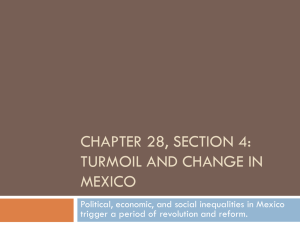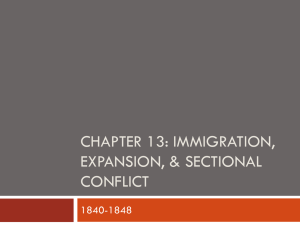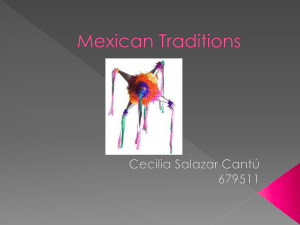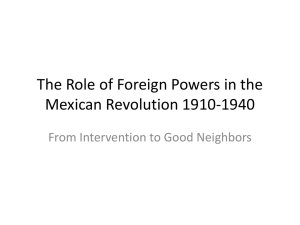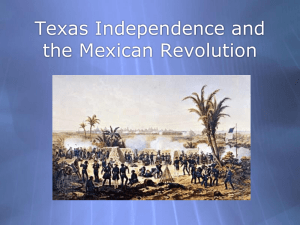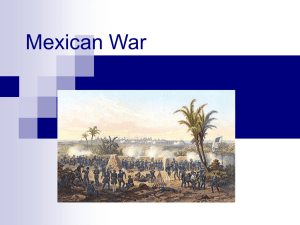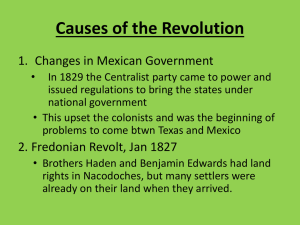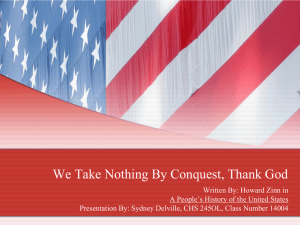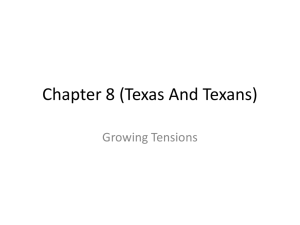The Mexican American War
advertisement
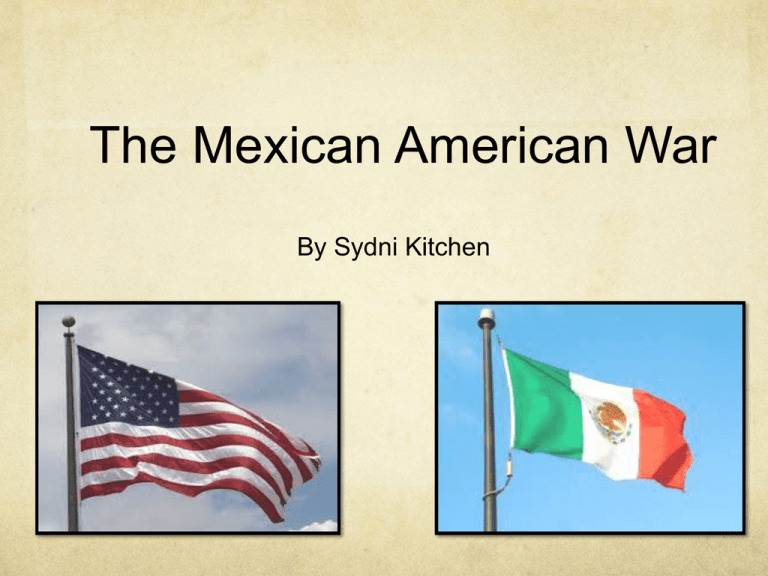
The Mexican American War By Sydni Kitchen Who was involved in the Mexican American War? The Mexican-American War was a war fought between the United States and Mexico between 1846 and 1848. Many types of people, religions, and states were involved in the war such as: Missouri, Mississippi, Kentucky, Utah, Nevada, California, Maine, Geywawa, Wahaka, Pwato, and DeLaCruz. All races were involved and all types of people and their backgrounds. Even ordinary people were called to war for the Mexican and Native American families were made to feel as foreigners in their own native land/homes. Causes of the Mexican American War •The Mexican-American War, also called Mexican War, Spanish Guerra de 1847, or Guerra de Estados Unidos a Mexico (“War of the United States Against Mexico”), was war between the United States and Mexico (April 1847February 1848). •It stemmed from the United States’ annexation of Texas in 1845 and from a dispute over whether Texas ended at the Nueces River (Mexican Claim), or the Rio Grande (U.S. claim). •The United States had disputed borders with Mexico. U.S. Congressman John Slidell went to Veracruz to try to negotiate with the Mexican government. He was authorized to offer $30 million for the the disputed Rio Grande border. The Mexican government refused to meet with John Slidell. •President Polk was determined to acquire the land. He sent American troops to Texas in January of 1846 to possibly provoke the Mexicans into war. •The United States democrats also had the belief of Manifest Destiny which is the idea that American should span from the East coast to the West Coast. Manifest destiny Manifest Destiny was the widely held belief that American settlers were predestined to expand and occupy the entire North American continent from the east coast to the west coast. This concept generated by the potential of a new earth for building a new “heaven”. The phrase itself meant many different things to many different people, and was rejected by many people. The democrats strongly supported Manifest Destiny and most Whigs strongly opposed it. The Manifest Destiny provided America the largest acquisition of U.S. territory. President James K. Polk used this to justify the war with Mexico. The Mexican American war begins On April 25, 1846, the Mexican cavalry attacked U.S. soldiers under the command of General Zachary Taylor killing or wounding 16 men. They then laid siege to an American fort along the Rio Grande. General Taylor called for reinforcements, and with the help of the superior rifles and artillery, they were able to defeat the Mexicans at the battles of Palo Alto and Resaca de la Palma. On May 9, 1846, President Polk announced that “Mexico has shed American blood on American soil.” He asked congress for an official declaration of War! On May 13, 1846 both houses of congress voted by a large majority to declare war on Mexico. The Mexican American War When war broke out against Mexico in May 1846, the United States Army had 8,000 men, but soon 60,000 volunteers joined. The American Navy dominated the sea. The American Government had stable capable leadership with a good economy which was superior to the Mexican Government. President James K. Polk directed the war from Washington, D.C. He sent a 4-prong attack into the Mexican heartland. He sent John Fremont to California, Stephen Kearny to New Mexico, Zachary Taylor at the Rio Grande, and Winfield Scott at Vera Cruz and Mexico City. James K. Polk James K. Polk was the 11th president of the United States. He promised the people he would annex Texas into the United States. When Mexico rejected American annexation of Texas, Polk led the nation to a victory in the Mexican-American War, which gave the United States most of its present Southwest. He strongly believed in “Manifest Destiny”. Bear Flag Revolt John C. Fremont was sent to control the coveted lands of California. Claiming to be on a mission to find a route to the Pacific, he began encouraging a parallel rebellion among the American settlers. He led a group of thirty-three settlers in Sonoma, assisted by volunteers in the Sacramento River valley, captured the Mexican garrison of Sonoma, and raised a homemade flag with a bear and star to symbolize their taking control. This was before word of hostilities reached the west. The words “California Republic” appeared on the flag but were never officially adopted by the insurgents. Their actions were later called the “Bear Flag Revolt.” Bear Flag Republic On July 4, 1846 American settlers in California declare themselves independent of Mexico and establish ‘Bear Flag’ Republic. The “Bear Flag Republic” was not taken seriously, but Fremont and his followers did march to Monterey to capture the Mexican Presidio, or fort. By 1847, California was secure. On July 7, 1846 The Mexican Congress officially declares war on the United States. Stephen Kearny Stephen Kearny led his troops into Santa Fe New Mexico in August of 1846 causing the governor of New Mexico to flee. Stephen Kearny was able to capture the city of Santa Fe without a single casualty. After capturing the city, he marched his army west across the desert to join John Fremont in California General Zachary Taylor Zachary Taylor was the 12th president of the United States from 1849-1850 and an American military leader. He crossed the Rio Grande with his troops upon President Polk’s order. He achieved fame leading American troops to victory in the Battle of Palo Alto and the Battle of Monterrey during the Mexican American War. Santa Anna Santa Anna, sometimes called "the Napoleon of the West," was a Mexican political leader, general, and eleven time president who greatly influenced early Mexican politics and government. Santa Anna fought first against Mexican independence from Spain, then in support of it. His military failures resulted in Mexico losing just over half its territory, beginning with the Texas Revolution and then with the Mexican Cessation of 1848. Santa Anna had been exiled to Cuba from the Mexican government. President Farias was going to allow Santa Anna back into Mexico to help with the war with the United States. He had secretly been dealing with representatives of the United States, pledging that if he were allowed back in Mexico through the U.S. naval blockades, he would work to sell all contested territory to the United States at a reasonable price. Once back in Mexico at the head of an army, Santa Anna reneged on both of these agreements. Santa Anna declared himself president again and unsuccessfully tried to fight off the United States invasion. Some of the Major Battles in the Mexican American War Battle of Palo Alto Battle of Resaca De La Palma Battle of Buena Vista Bombardment of Veracruz The Battle of Palo Alto On May 8, 1846 the first major battle of the Mexican American war had begun. Also on this day General Zachary Taylor was authorized to move south into disputed territory. The Battle of Resaca De La Palma General Mariano Arista deploys his forces in an empty lake bed with his army in a narrow line. General Taylor attacks his center, overrunning the Mexican artillery. Mexicans retreat across the Rio Grande, 200 Mexican casualties and only 39 American casualties. The Battle of Buena Vista February 22, 1847 Shortly after sunrise Santa Anna’s 18,000 soldiers appear and sends a surrender order to General Taylor who rejects it. Indecisive firefights for higher ground. The flying artillery breaks up Mexican attacks. Mexicans loose 1,800, Americans loose 267 killed with 1,500 desertions. Santa Anna orders retreat at night toward Agua Nueva. Taylor heads toward Monterrey. Bombardment at Veracruz U.S. troops led by General Winfield Scott landed in Veracruz and took over the city. They then began marching toward Mexico City. The Mexicans resisted at Cerro Gordo and elsewhere, but were defeated each time. In September 1847, Scott successfully laid siege to Mexico City’s Chapultepec Castle. During that clash, a group of military school cadets– the so-called niños héroes– reportedly committed suicide rather than surrender. THE MEXICAN AMERICAN WAR ENDS WITH THE SIGNING OF THE TREATY OF GUADALUPE HIDALGO Treaty of Guadalupe Hidalgo February 2, 1848, Mexicans signed the Treaty of Guadalupe Hidalgo. Mexico ceded, or gave up all of California, and New Mexico. Under the treaty, Mexico also recognized the U.S. annexation of Texas, and agreed to sell California and the rest of its territory north of the Rio Grande for $15 million plus the assumption of certain damages claims. Terms of the Treaty of Guadalupe Hidalgo The Treaty of Guadalupe Hidalgo gave the United States the area of New Mexico, Arizona, California, Nevada, Utah, and portions of Colorado and Wyoming. How did the American victory effect the United States? It took away more than 1/3 of Mexico’s claimed territories. For the Americans this was their first real war/fight with a foreign country The war resulted in the United States’ acquisition of more than 500,000 square miles (1,300,000 square km) of Mexican territory extending westward from the Rio Grande to the Pacific Ocean.
